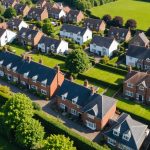Essential Steps for Sustainable Home Transformation
Understanding your home’s current energy consumption is the foundation of sustainable home improvements. Begin by assessing key areas where energy is lost or inefficient—such as heating systems, insulation, and lighting. This targeted evaluation helps prioritize areas offering the greatest impact for eco-friendly renovations UK residents commonly undertake.
Next, focus on low-cost, high-impact changes. Simple steps like installing LED lighting, adding draught excluders to windows and doors, or using water-efficient fixtures can reduce energy and water use significantly without large upfront investment. These improvements are excellent examples of initial green home upgrades accessible to most homeowners.
In the same genre : How Can You Enhance Your UK Home’s Comfort and Style with Minimal Changes?
For those planning a comprehensive renovation, a clear strategy is essential. Prioritize phases for integrating better-insulated walls, eco-conscious flooring, and energy-efficient appliances. Scheduling upgrades thoughtfully helps manage budget constraints while steadily boosting sustainability. Consider future-ready systems such as smart heating controls that can optimize energy use automatically.
By following these essential steps, homeowners in the UK can confidently begin a sustainable home transformation that combines practicality with environmental responsibility.
This might interest you : How can you create a minimalist aesthetic in a UK apartment?
Maximising Energy Efficiency in UK Homes
Improving energy efficiency in UK homes starts with upgrading insulation, draught-proofing, and windows. Given the UK’s temperate climate, proper insulation limits heat loss and reduces heating demands, a major source of energy use. Draught-proofing doors and windows further prevents cold air infiltration, enhancing comfort while cutting costs.
Smart technologies also advance energy efficiency significantly. Installing smart thermostats allows precise temperature control, adapting to homeowner routines and minimizing waste. Coupling these with energy-efficient appliances and LED lighting ensures continuous performance gains throughout the home.
Renewable energy adoption is increasingly accessible for UK households. Options such as solar panels and heat pumps harness natural resources, providing clean power while lowering reliance on fossil fuels. Government incentives often offset installation costs, making renewables a practical step in eco-friendly renovations in the UK.
Together, these energy efficiency upgrades create warmer, greener homes with lower bills. By blending modern insulation, smart controls, and renewables, homeowners achieve a substantial environmental impact with measurable financial benefits.
Sourcing Eco-Friendly and Sustainable Materials
Choosing the right sustainable building materials UK is crucial for eco-friendly renovations UK homeowners want to achieve lasting, positive impacts. Start by selecting low-impact paints and insulation products certified safe for the environment and human health. Materials such as natural clay plasters or sheep’s wool insulation combine performance with sustainability.
Reclaimed and recycled building supplies reduce demand on virgin resources and help lower renovation waste. For example, reclaimed timber flooring or recycled glass countertops add character while supporting circular economy principles. Local sourcing further cuts environmental footprints by minimising transport emissions and supporting UK suppliers who prioritise eco-friendly home products.
When evaluating materials, look for trusted UK certifications like the FSC (Forest Stewardship Council) for wood or BES 6001 for responsible sourcing. These marks assure quality and adherence to sustainability standards. Combining certified, reclaimed, and locally sourced materials strengthens your sustainable home improvements, blending ecological responsibility with practical durability. Homeowners can thus confidently invest in green home upgrades that benefit both the environment and their living spaces.
Essential Steps for Sustainable Home Transformation
Before starting any sustainable home improvements, a thorough assessment of your home’s current energy use is vital. Identify priority areas where energy loss or inefficiency is highest—typically heating, insulation, and lighting. This focused evaluation guides which eco-friendly renovations UK homeowners should tackle first for maximum impact.
Implementing low-cost, high-impact sustainability changes is an effective starting point. Examples include sealing gaps to prevent draughts, switching to LED lighting, or installing water-saving fixtures. These green home upgrades reduce energy and water consumption quickly without major investment, making them accessible to most households.
For comprehensive upgrades, planning is key. Develop a phased strategy to integrate advanced solutions such as improved wall insulation, energy-efficient appliances, and smart heating controls. Such coordination balances budget limits while steadily enhancing sustainability. Prioritising these well-structured steps ensures eco-friendly renovations UK residents undertake are both practical and environmentally responsible.
Essential Steps for Sustainable Home Transformation
The first step in sustainable home improvements is a detailed assessment of your home’s current energy use. Pinpointing priority areas, such as inefficient heating or poor insulation, allows targeted action on the biggest energy drains. This focused evaluation is essential for effective eco-friendly renovations UK residents undertake.
Implementing low-cost, high-impact green home upgrades offers quick results with manageable investment. For example, sealing gaps to prevent draughts, switching to LED lighting, and fitting water-efficient fixtures can slash energy and water consumption immediately while setting a foundation for deeper changes.
Planning for comprehensive renovations involves creating a phased strategy. Prioritize enhancements like improved wall insulation, energy-efficient appliances, and smart controls. Thoughtful scheduling balances budget constraints and convenience, ensuring gradual but continuous sustainability gains. This approach makes eco-friendly renovations UK homeowners more achievable and practical, turning initial upgrades into long-term improvements.
Essential Steps for Sustainable Home Transformation
The cornerstone of sustainable home improvements begins with a detailed assessment of your home’s current energy use. Identifying priority areas like outdated heating systems, poor insulation, or inefficient lighting pinpoints where energy is lost most. This targeted analysis ensures that eco-friendly renovations UK homeowners pursue focus on achieving the largest impact first.
Low-cost, high-impact green home upgrades provide accessible starting points. For instance, sealing draughts around windows and doors improves comfort and reduces heat loss with minimal expense. Switching to LED lighting cuts electricity use dramatically and fitting water-efficient fixtures lowers water bills, supporting sustainability goals on tight budgets.
For more comprehensive projects, a clear and phased plan is essential. Break renovations into manageable stages incorporating advanced insulation, energy-efficient appliances, and smart heating controls. This strategic approach aids in balancing costs and convenience, making the pathway to greener living practical for UK homeowners. Thoughtful planning turns initial improvements into lasting eco-friendly renovations UK residents can maintain and build upon confidently.



